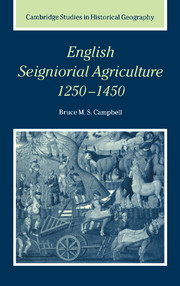Book contents
- Frontmatter
- Contents
- List of figures
- List of tables
- Preface and acknowledgements
- Abbreviations
- Weights, measures, values, and boundaries
- 1 Introduction: agriculture and the late-medieval English economy
- 2 Sources, databases, and typologies
- 3 The scale and composition of the seigniorial sector
- 4 Seigniorial pastoral production
- 5 Seigniorial arable production
- 6 Crop specialisation and cropping systems
- 7 Arable productivity
- 8 Grain output and population: a conundrum
- 9 Adapting to change: English seigniorial agriculture 1250–1450
- Appendix 1 Demesne-level classification of husbandry types
- Appendix 2 Demesnes represented in the Norfolk accounts database
- Appendix 3 Demesnes represented in the FTC accounts databases
- Consolidated bibliography
- Index
- Cambridge Studies in Historical Geography
5 - Seigniorial arable production
Published online by Cambridge University Press: 20 October 2009
- Frontmatter
- Contents
- List of figures
- List of tables
- Preface and acknowledgements
- Abbreviations
- Weights, measures, values, and boundaries
- 1 Introduction: agriculture and the late-medieval English economy
- 2 Sources, databases, and typologies
- 3 The scale and composition of the seigniorial sector
- 4 Seigniorial pastoral production
- 5 Seigniorial arable production
- 6 Crop specialisation and cropping systems
- 7 Arable productivity
- 8 Grain output and population: a conundrum
- 9 Adapting to change: English seigniorial agriculture 1250–1450
- Appendix 1 Demesne-level classification of husbandry types
- Appendix 2 Demesnes represented in the Norfolk accounts database
- Appendix 3 Demesnes represented in the FTC accounts databases
- Consolidated bibliography
- Index
- Cambridge Studies in Historical Geography
Summary
Carnivorous as lords and their immediate households may have been, the typical lowland demesne was a predominantly arable concern. Nationally, the arable comprised 60 per cent of all demesne land-use by value in the first half of the fourteenth century (Table 3.01) and on roughly one in three of all demesnes that proportion rose to three-quarters. The arable bias to demesne land-use was particularly marked within the ten FTC counties, which had to feed both themselves and London. Crops and crop products accounted for 84 per cent of gross agricultural output on demesnes within these counties c. 1300, a proportion which is consistent with Clark's estimate that within lowland England ‘arable crops accounted for 80 per cent by value of total food output c. 1300’. Underpinning that pronounced production bias were buoyant grain prices and an abundant cheap labour force. By the close of the fourteenth century relative prices and factor costs were less favourable, yet although the arable sector's dominance weakened, it was by no means eclipsed. As a proportion of demesne land-use within the FTC counties the arable declined from 67 per cent to 60 per cent of the total. Bolstered by the proximity of London, arable products continued to contribute half of all gross sales revenue compared with 60 per cent at the beginning of the century.
In the vast majority of cases, therefore, crop production was, and long remained, the first concern of demesne managers. To it they devoted the larger share of their resources and upon it they depended for the greater part of their gross income. There were exceptions, of course, and where circumstance and opportunity dictated the arable sector took second place to the pastoral.
- Type
- Chapter
- Information
- English Seigniorial Agriculture, 1250–1450 , pp. 188 - 248Publisher: Cambridge University PressPrint publication year: 2000



